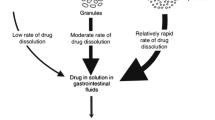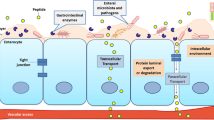Abstract
This study is focused on the design of gastro-retentive drug delivery system composed of hollow microspheres (microballoons) for the sustained delivery of cinnarizine (CIN). The microballoons (MBs) were prepared by the emulsion solvent diffusion method using cellulose acetate butyrate (CAB) as the hosting polymer and absolute ethanol (ETH) and dichloromethane (DCM) as solvents. A 33 full factorial experimental design was adopted to study the effect of different variables and to find an optimum formula with desired properties. Prepared microballoons showed high drug loading capacities and controlled release behaviour. The optimum formulation was chosen on the basis of achieving maximum values for both drug loading capacity and release efficiency as well as having suitable size. The optimized MB (MB-F21) was composed of 200 mg CIN and 400 mg CAB with a DCM/ETH ratio of 2:1. Scanning electron microscopy for the optimum formulation showed a spherical outline with internal porous structure. An in vivo study using human volunteers was performed by determination of CIN concentration in the plasma using the liquid chromatography-mass spectrometry (LC-MS) method. Results proved the superiority of the designed formulation over the market product Stuval® tablets in bioavailability parameters comprising T max as well as area under the plasma CIN concentration-time curve (AUC0–24 h) and AUC0–∞ values. Also, the significantly greater value of mean residence time (MRT) in case of MB-F21 indicates its higher gastric residence time and proves the advantages of micro-multiparticulate dosage forms over conventional one.






Similar content being viewed by others
References
Bechgaard H, Ladefoged K. Distribution of pellets in the gastrointestinal tract. The influence on transit time exerted by the density or diameter of pellets. J Pharm Pharmacol. 1978;30:690–2.
Bechgaard H, Nielson GH. Controlled release multiple units and single unit doses. Drug Dev Ind Pharm. 1978;4:53–67.
Vervaet C, Baert L, Remon JP. Extrusion-spheronization: a literature review. Int J Pharm. 1995;116:131–46.
Streubel A, Siepmann J, Bodmeier R. Multiple unit gastroretentive drug delivery systems: a new preparation method for low density microparticles. J Microencapsul. 2003;20(3):329–47.
Scholtz AW et al. Treatment of vertigo due to acute unilateral vestibular loss with a fixed combination of cinnarizine and dimenhydrinate: a double-blind, randomized, parallel-group clinical study. Clin Ther. 2004;26(6):866–77.
Alhnan MA, Murdan S, Basit AW. Encapsulation of poorly soluble basic drugs into enteric microparticles: a novel approach to enhance their oral bioavailability. Int J Pharm. 2011;416:55–60.
Novotny M, Kostrica R. Fixed combination of cinnarizine and dimenhydrinate vs betahistine dimesylate in the treatment of Meniere’s disease: a randomized, double-blind, parallel group clinical study. Int Tinnitus J. 2002;8(2):115–23.
Togha M, Ashrafian H, Tajik P. Open-label trial of cinnarizine in migraine prophylaxis. Headache. 2006;46(3):498–502.
Turner D et al. Pediatric cinnarizine overdose and toxicokinetics. Pediatrics. 2006;117(5):1067–9.
Shi S et al. Pharmacokinetics, tissue distribution and safety of cinnarizine delivered in lipid emulsion. Int J Pharm. 2010;383:264–70.
Loftsson T, Hreinsdóttir D, Másson M. Evaluation of cyclodextrin solubilization of drugs. Int J Pharm. 2005;302:18–28.
Kalava BS, Demirel M, Yazan Y. Physicochemical characterisation and dissolution properties of cinnarizine solid dispersions. Turk J Pharm Sci. 2005;2:51–62.
Radke RS et al. Formulation and evaluation of sustained release system for an effective management of motion sickness. RJPT. 2008;1(4):426–9.
Scott LJ, Perry CM. Tramadol: a review of its use in perioperative pain. Drugs. 2000;60(1):139–76.
Chang L et al. Optimization of epirubicin nanoparticles using experimental design for enhanced intravesical drug delivery. Int J Pharm. 2009;376:195–203.
Renoux R et al. Experimentally designed optimization of direct compression tablets. Drug Dev Ind Pharm. 1996;22:103–9.
Montgomery D. Design and analysis of experiments. New York: Wiley; 1997. p. 84–6.
Soppimath KS et al. Microspheres as floating drug delivery system to increase the gastric residence of drugs. Drug Metab Rev. 2001;33:149–60.
Obeidat WM, Price JC. Evaluation of enteric matrix microspheres prepared by emulsion-solvent evaporation using scanning electron microscopy. J Microencapsul. 2004;21:47–57.
Obeidat WM, Price JC. Preparation and in vitro evaluation of propylthiouracil microspheres made of Eudragit RL 100 and cellulose acetate butyrate polymers using the emulsion-solvent evaporation method. J Microencapsul. 2005;22(3):281–9.
Miyazaki Y et al. Release profiles of theophylline from microspheres consisting of dextran derivatives and cellulose acetate butyrate: effect of polyion complex formation. Drug Dev Ind Pharm. 2003;29:795–804.
Rokhade AP et al. Preparation and evaluation of cellulose acetate butyrate and poly(ethylene oxide) blend microspheres for gastroretentive floating delivery of repaglinide. J Appl Polym Sci. 2007;105:2764–71.
Gupta PK, Robinson JR. Oral controlled-release delivery. In: Kydonieus A, editor. Treatise on controlled drug delivery. New York: Marcel Dekker; 1992. p. 255–313.
Tang Y et al. Sustained release of hydrophobic and hydrophilic drugs from a floating dosage form. Int J Pharm. 2007;336:159–65.
Kawashima Y et al. Hollow microspheres for use as a floating controlled drug delivery system in the stomach. J Pharm Sci. 1992;81:135–40.
Huang YB et al. Once-daily propranolol extended-release tablet dosage form: formulation design and in vitro/in vivo investigation. Eur J Pharm Biopharm. 2004;58:607–14.
Ahmed MM et al. Emulsification/internal gelation as a method for preparation of diclofenac sodium-sodium alginate microparticles. Saudi Pharm J. 2013;21(1):61–9.
Sato Y et al. Physicochemical properties to determine the buoyancy of hollow microspheres (microballoons) prepared by the emulsion solvent diffusion method. Eur J Pharm Biopharm. 2003;55:297–304.
Sato Y et al. In vitro evaluation of floating and drug releasing behaviors of hollow microspheres (microballoons) prepared by the emulsion solvent diffusion method. Eur J Pharm Biopharm. 2004;57:235–43.
Martinez MN, Amidon GL. A mechanistic approach to understanding the factors affecting drug absorption: a review of fundamentals. J Clin Pharmacol. 2002;42(6):620–43.
Jain SK et al. Calcium silicate based microspheres of repaglinide for gastroretentive floating drug delivery: preparation and in vitro characterization. J Control Release. 2005;107(2):300–9.
Patel DM et al. Floating granules of ranitidine hydrochloride-gelucire 43/01: formulation optimization using factorial design. AAPS Pharm Sci Tech. 2007;8(2):30.
Sato Y et al. In vitro and in vivo evaluation of riboflavin-containing microballoons for a floating controlled drug delivery system in healthy humans. Int J Pharm. 2004;275(1–2):97–107.
Varshosaz J, Tabbakhian M, Zahrooni M. Development and characterization of floating microballoons for oral delivery of cinnarizine by a factorial design. J Microencapsul. 2007;24(3):253–62.
Mastiholimath VS et al. In vitro and in vivo evaluation of ranitidine hydrochloride ethyl cellulose floating microparticles. J Microencapsul. 2008;25(5):307–14.
Nepal PR, Chun M, Choi H. Preparation of floating microspheres for fish farming. Int J Pharm. 2007;341:85–90.
Kawashima Y et al. Preparation of multiple unit hollow microspheres (microballoons) with acrylic resin containing tranilast and their drug release characteristics (in vitro) and floating behavior (in vivo). J Control Release. 1991;16:279–90.
Kamel R, Basha M, Elawdan S. Development and evaluation of long-acting epidural “smart” thermoreversible injection loaded with spray-dried polymeric nanospheres using experimental design. J Drug Target. 2013;21(3):277–90.
Birajdar A et al. Design and evaluation of glipizide containing microballoons for floating controlled drug delivery system. IJPI’s J Pharm Cosmet. 2012;2(8):43–5.
Hooda A et al. Optimization and evaluation of gastroretentive ranitidine HCl microspheres by using design expert software. Int J Biol Macromol. 2012;51(5):691–700.
Porwal A, Swami G, Saraf S. Preparation and evaluation of sustained release microballoons of propranolol. DARU. 2011;19(3):193–201.
Sood A, Panchagnula R. Role of dissolution studies in controlled release drug delivery system. STP Pharma Sci. 1999;9(2):157–68.
Kamel R, Mahmoud A, El-Feky G. Double-phase hydrogel for buccal delivery of tramadol. Drug Dev Ind Pharm. 2012;38(4):468–83.
Thanoo BC, Sunny MC, Jayakrishnan A. Oral sustained release drug delivery systems using polycarbonate microspheres capable of floating on the gastric fluids. J Pharm Pharmacol. 1993;45:21–4.
Yeo Y, Park K. Control of encapsulation efficiency and initial burst in polymeric microparticle systems. Arch Pharm Res. 2004;27(1):1–12.
Basalious EB, Shawky N, Badr-Eldin SM. SNEDDS containing bioenhancers for improvement of dissolution and oral absorption of lacidipine. I: development and optimization. Int J Pharm. 2010;391:203–11.
Author information
Authors and Affiliations
Corresponding author
Ethics declarations
Conflict of interest
The authors declare that they have no competing interests.
Rights and permissions
About this article
Cite this article
Ammar, H.O., Ghorab, M., Kamel, R. et al. Design and optimization of gastro-retentive microballoons for enhanced bioavailability of cinnarizine. Drug Deliv. and Transl. Res. 6, 210–224 (2016). https://doi.org/10.1007/s13346-016-0280-4
Published:
Issue Date:
DOI: https://doi.org/10.1007/s13346-016-0280-4




